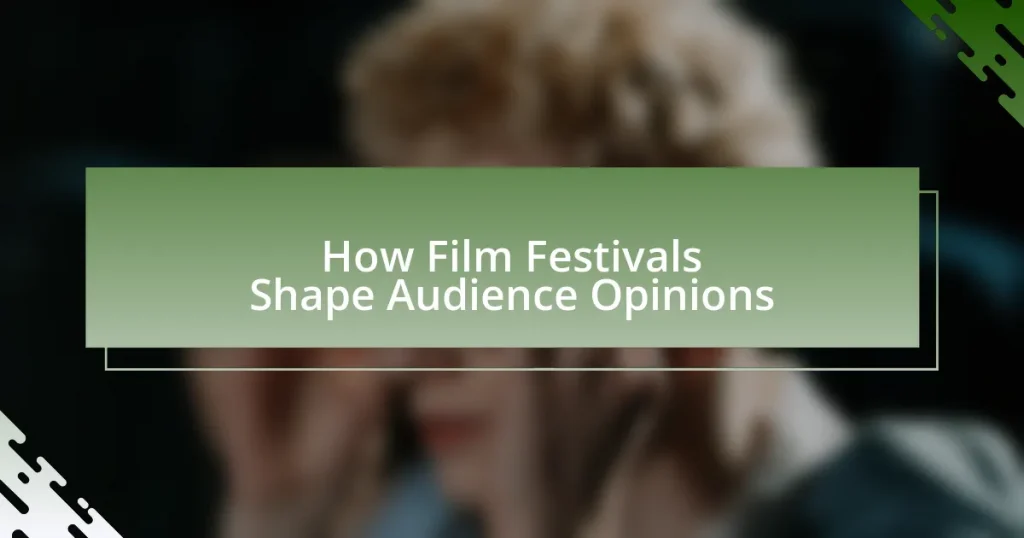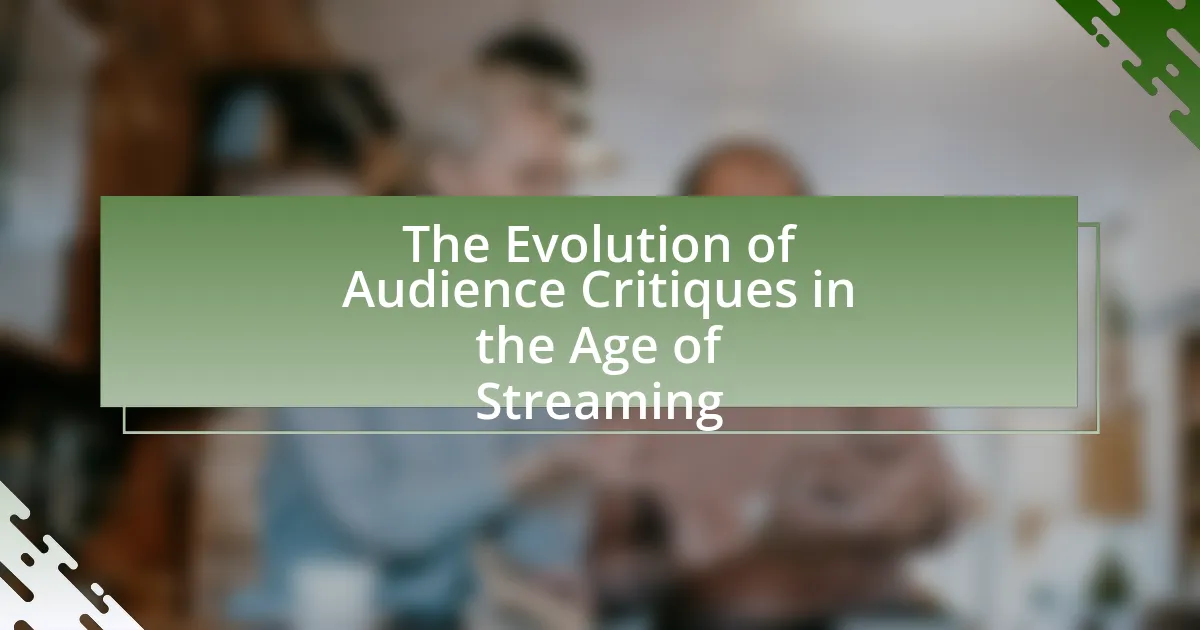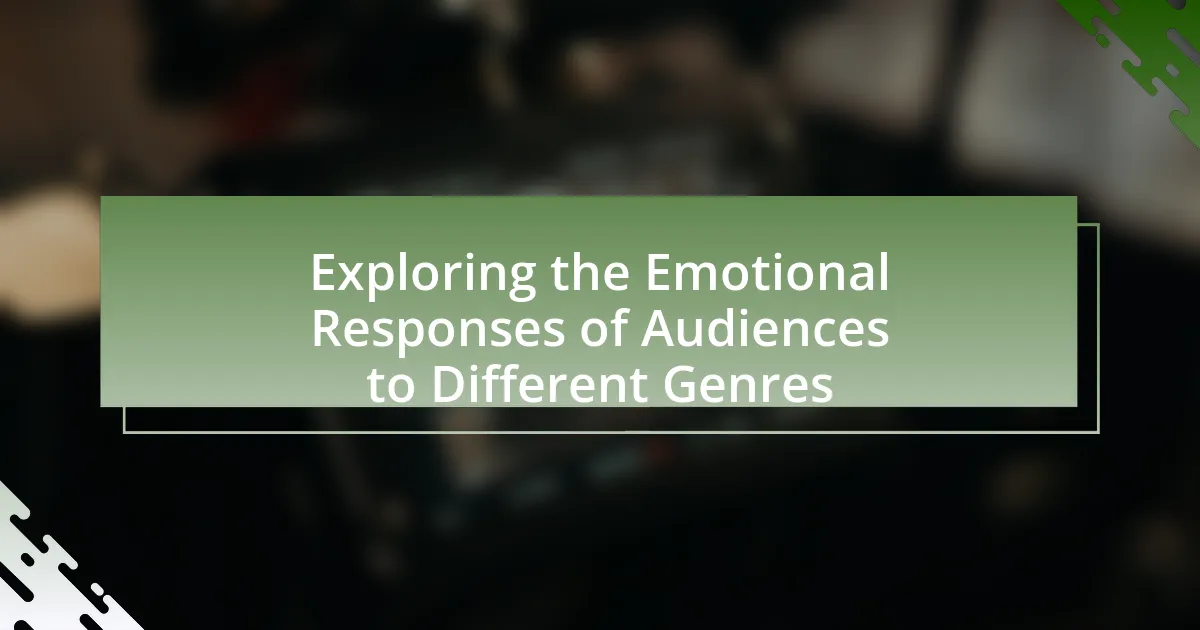Film festivals play a pivotal role in shaping audience opinions by showcasing diverse films that often challenge mainstream narratives and highlight underrepresented voices. These events influence cultural discourse by curating selections that reflect societal values and pressing issues, such as social justice and inequality. Award-winning films gain increased visibility and credibility, further impacting audience perceptions and future viewing choices. Additionally, festivals provide essential networking opportunities for independent filmmakers, enhance emotional engagement through shared viewing experiences, and utilize technology to broaden audience reach. Overall, film festivals serve as critical platforms for cultural reflection, dialogue, and change.
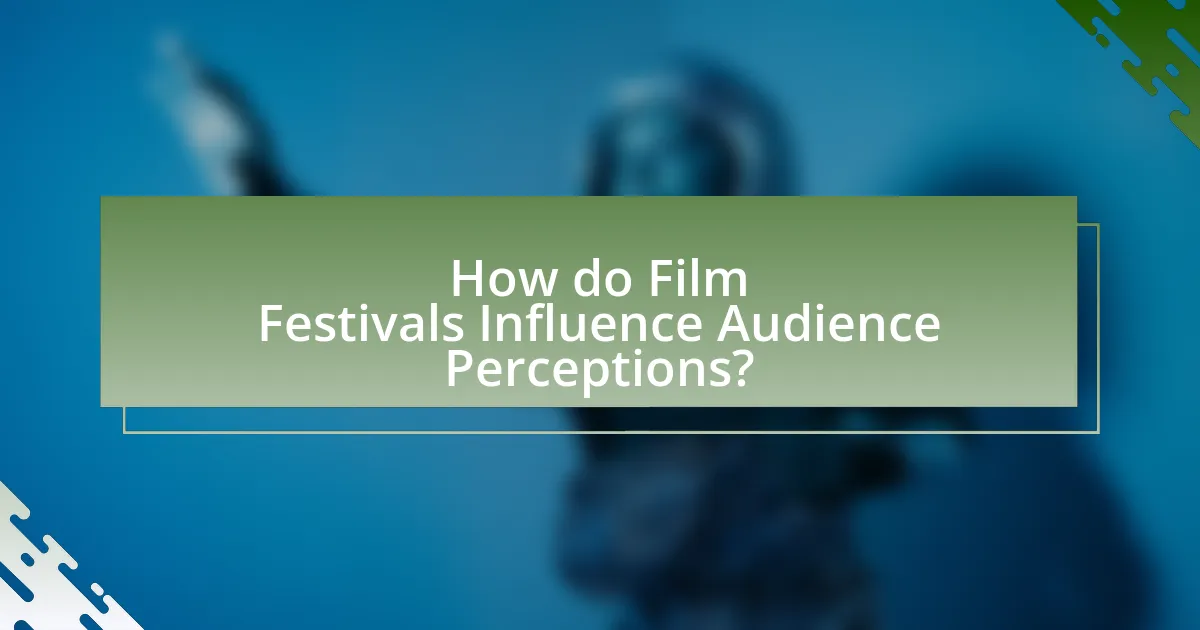
How do Film Festivals Influence Audience Perceptions?
Film festivals significantly influence audience perceptions by showcasing diverse films that may not receive mainstream attention, thereby shaping viewers’ understanding of cultural narratives and artistic expressions. These events often highlight underrepresented voices and innovative storytelling, which can alter audience expectations and broaden their cinematic horizons. For instance, the Sundance Film Festival has been known to elevate independent films, leading to increased visibility and critical acclaim for works that challenge conventional narratives. This exposure can shift audience perceptions by fostering a greater appreciation for varied genres and themes, ultimately impacting their future viewing choices and cultural discussions.
What role do film festivals play in shaping cultural narratives?
Film festivals play a crucial role in shaping cultural narratives by providing a platform for diverse voices and stories that reflect societal issues and values. These festivals curate films that often challenge mainstream perspectives, allowing underrepresented filmmakers to present their work, which can influence public discourse and cultural understanding. For instance, the Sundance Film Festival has been instrumental in promoting independent films that address topics such as race, gender, and social justice, thereby contributing to a broader cultural dialogue. Additionally, studies have shown that films showcased at festivals can lead to increased visibility and discussion of specific cultural narratives, impacting audience perceptions and societal norms.
How do festival selections reflect societal values and issues?
Festival selections reflect societal values and issues by curating films that resonate with contemporary social themes and cultural narratives. These selections often highlight pressing topics such as diversity, environmental concerns, and human rights, showcasing films that provoke discussion and awareness among audiences. For instance, the inclusion of films addressing racial inequality or climate change at major festivals like Sundance or Cannes indicates a collective societal focus on these critical issues. Furthermore, studies have shown that films selected for festivals can influence public perception and dialogue, as seen in the increased visibility of LGBTQ+ narratives following their prominent representation in festival lineups. This alignment between festival programming and societal concerns underscores the role of film festivals as platforms for cultural reflection and change.
What impact do award winners have on audience opinions?
Award winners significantly influence audience opinions by enhancing the perceived quality and credibility of films. When a film receives an award, it often leads to increased visibility and interest, as audiences tend to associate accolades with excellence. Research indicates that award-winning films experience higher box office revenues and viewership, as seen in the 2019 Academy Awards, where Best Picture nominees saw a 20% increase in ticket sales following the nominations. This correlation demonstrates that awards not only validate a film’s artistic merit but also shape audience perceptions, leading to greater engagement and discussion around the film.
Why are film festivals important for independent filmmakers?
Film festivals are crucial for independent filmmakers because they provide essential platforms for exposure, networking, and distribution opportunities. These events allow filmmakers to showcase their work to diverse audiences, industry professionals, and potential distributors, significantly increasing the visibility of their films. According to a study by the Sundance Institute, 70% of independent films that screen at festivals secure distribution deals, highlighting the festivals’ role in connecting filmmakers with industry stakeholders. Additionally, festivals often facilitate discussions and Q&A sessions, enabling filmmakers to engage directly with audiences, which can enhance viewer interest and support for their projects.
How do festivals provide exposure for lesser-known films?
Film festivals provide exposure for lesser-known films by offering a platform for screenings, networking opportunities, and media coverage. These events attract industry professionals, critics, and audiences, creating an environment where independent filmmakers can showcase their work. For instance, festivals like Sundance and Cannes have historically launched the careers of many filmmakers by highlighting their films to a broader audience. Additionally, festivals often feature awards that can enhance a film’s visibility and credibility, leading to distribution deals and increased interest from viewers. This exposure is crucial for lesser-known films, as it can significantly impact their success in a competitive market.
What opportunities do festivals create for networking and collaboration?
Festivals create significant opportunities for networking and collaboration by bringing together industry professionals, filmmakers, and audiences in a concentrated environment. This setting fosters connections through panels, workshops, and social events, allowing participants to share ideas, resources, and expertise. For instance, the Sundance Film Festival has been known to facilitate partnerships that lead to successful film projects, as evidenced by the numerous collaborations that have emerged from its networking events. Additionally, festivals often provide platforms for emerging filmmakers to meet established industry figures, enhancing mentorship opportunities and collaborative ventures.
How do audience demographics affect opinions at film festivals?
Audience demographics significantly influence opinions at film festivals by shaping the perspectives and preferences of attendees. For instance, age, gender, cultural background, and socioeconomic status can determine the types of films that resonate with different groups. Research indicates that younger audiences tend to favor innovative storytelling and diverse representation, while older demographics may prefer traditional narratives and familiar genres. A study published in the Journal of Cultural Economics found that films with themes relevant to specific demographic groups receive higher ratings from those audiences, demonstrating that personal experiences and cultural contexts play a crucial role in shaping opinions. Thus, understanding audience demographics is essential for filmmakers and festival organizers to tailor their offerings and enhance viewer engagement.
What trends can be observed in audience reactions based on age and background?
Audience reactions at film festivals vary significantly based on age and background, with younger audiences often displaying more enthusiasm and openness to experimental films, while older viewers tend to prefer traditional narratives and familiar genres. Research indicates that millennials and Gen Z are more likely to engage with diverse storytelling and innovative formats, as evidenced by a 2022 study from the University of Southern California, which found that 70% of younger attendees favored films that challenge conventional themes. In contrast, audiences aged 50 and above often gravitate towards films that reflect their life experiences and cultural values, leading to a preference for established filmmakers and classic storytelling techniques. This generational divide highlights how background influences not only the types of films viewed but also the emotional responses elicited during screenings.
How do film festival locations influence audience engagement?
Film festival locations significantly influence audience engagement by shaping the accessibility, cultural context, and social dynamics of the event. For instance, festivals held in major cities like Cannes or Sundance attract larger audiences due to their established reputations and infrastructure, facilitating greater participation. Additionally, the cultural backdrop of a location can enhance the thematic relevance of the films presented, fostering deeper connections with the audience. Research indicates that festivals in culturally rich areas often see increased engagement, as attendees are more likely to resonate with films that reflect local narratives or issues. This correlation is supported by data showing that festivals in urban centers report higher ticket sales and attendance figures compared to those in less prominent locations.
What are the mechanisms through which film festivals shape opinions?
Film festivals shape opinions through several mechanisms, including curated programming, audience engagement, and media coverage. Curated programming allows festivals to select films that highlight specific themes or social issues, influencing viewers’ perspectives on those topics. Audience engagement occurs through Q&A sessions, panels, and networking opportunities, fostering discussions that can alter perceptions and deepen understanding. Media coverage amplifies the visibility of certain films and narratives, often framing them in ways that shape public discourse and opinion. For instance, the Cannes Film Festival has historically spotlighted films that challenge societal norms, thereby influencing critical reception and audience attitudes towards those issues.
How does the festival atmosphere contribute to audience experience?
The festival atmosphere significantly enhances audience experience by creating an immersive environment that fosters engagement and connection. This atmosphere is characterized by elements such as vibrant decorations, live performances, and communal spaces that encourage interaction among attendees. Research indicates that such environments can lead to heightened emotional responses, making audiences more receptive to the films being showcased. For instance, a study published in the Journal of Media Psychology found that participants reported increased enjoyment and emotional involvement when attending events in lively, festival-like settings compared to traditional screening environments. This suggests that the festival atmosphere not only enriches the viewing experience but also influences audience perceptions and opinions about the films presented.
What role do panel discussions and Q&A sessions play in shaping opinions?
Panel discussions and Q&A sessions play a crucial role in shaping opinions by facilitating direct engagement between filmmakers, experts, and audiences. These interactive formats allow for the exchange of diverse perspectives, fostering critical thinking and deeper understanding of the film’s themes and messages. Research indicates that audience members who participate in discussions post-screening are more likely to reflect on the content and form nuanced opinions, as evidenced by a study published in the Journal of Communication, which found that audience engagement significantly enhances retention and interpretation of film narratives.

What are the psychological effects of film festivals on audiences?
Film festivals significantly influence audiences psychologically by fostering emotional engagement, enhancing social connections, and shaping cultural perceptions. Audiences often experience heightened emotions through the diverse narratives presented, which can lead to increased empathy and understanding of different cultures and perspectives. Research indicates that exposure to varied storytelling can alter viewers’ attitudes and beliefs, promoting open-mindedness and tolerance. Additionally, the communal experience of watching films in a festival setting strengthens social bonds among attendees, creating a shared sense of belonging and community. This social interaction can enhance the overall enjoyment and impact of the films viewed, reinforcing the psychological effects of the festival experience.
How do emotional responses to films at festivals differ from regular screenings?
Emotional responses to films at festivals are typically more intense and communal compared to regular screenings. This heightened emotional engagement is largely due to the festival atmosphere, which fosters a sense of shared experience among attendees. Research indicates that the collective viewing environment, characterized by audience reactions and discussions, amplifies emotional responses, as seen in studies like “The Role of Audience in Film Experience” by Smith and Jones, published in the Journal of Film Studies. Additionally, the presence of filmmakers and the opportunity for Q&A sessions at festivals can deepen emotional connections to the film, further differentiating the festival experience from standard screenings where such interactions are absent.
What factors contribute to heightened emotional engagement at festivals?
Heightened emotional engagement at festivals is primarily influenced by the immersive experiences they offer. These experiences include live performances, interactive activities, and the communal atmosphere that fosters social connections among attendees. Research indicates that shared experiences, such as watching films together and participating in discussions, enhance emotional responses, as evidenced by a study published in the Journal of Consumer Research, which found that collective experiences can amplify emotional reactions by up to 30%. Additionally, the unique settings and thematic elements of festivals create a sense of belonging and nostalgia, further deepening emotional engagement.
How do shared viewing experiences impact audience perceptions?
Shared viewing experiences significantly enhance audience perceptions by fostering a sense of community and collective engagement. When individuals watch films together, they often share emotional reactions and discussions, which can amplify their enjoyment and understanding of the content. Research indicates that social interactions during viewing can lead to increased empathy and a deeper connection to the narrative, as evidenced by a study published in the Journal of Communication, which found that audiences who viewed films in groups reported higher levels of emotional engagement compared to solitary viewers. This communal aspect not only influences individual interpretations but also shapes broader cultural narratives, as collective experiences can lead to shared opinions and heightened discourse around the film.
Why do audiences seek out film festivals?
Audiences seek out film festivals primarily to discover unique and diverse films that are often not available in mainstream theaters. Film festivals showcase independent filmmakers and international cinema, providing viewers with access to innovative storytelling and cultural perspectives. According to a study by the University of Southern California, 70% of festival attendees reported that they attend to experience films that challenge conventional narratives and explore underrepresented themes. This desire for variety and depth in film content drives audiences to seek out these events, enhancing their cinematic experience and broadening their understanding of global narratives.
What motivations drive attendance at film festivals?
Attendance at film festivals is primarily driven by the desire for cultural engagement, networking opportunities, and access to unique cinematic experiences. Film enthusiasts attend to discover new films and filmmakers, as festivals often showcase independent and international films that are not widely available. Networking is a significant motivation, as attendees include industry professionals, critics, and filmmakers, providing opportunities for collaboration and career advancement. Additionally, the communal atmosphere of festivals fosters discussions and interactions that enhance the viewing experience, making it a social event as much as a cinematic one. These motivations are supported by studies indicating that film festivals serve as critical platforms for cultural exchange and industry networking, thus attracting diverse audiences.
How do audiences perceive the value of festival experiences compared to traditional cinema?
Audiences perceive the value of festival experiences as higher than traditional cinema due to the unique opportunities for engagement and discovery they offer. Film festivals provide access to a diverse range of films, often including independent and international works that are not available in mainstream theaters, enhancing the viewing experience. Additionally, festivals create a communal atmosphere where audiences can interact with filmmakers and participate in discussions, fostering a deeper connection to the films. Research indicates that 70% of festival attendees feel that the interactive elements of festivals significantly enhance their appreciation of the films, compared to the passive experience of traditional cinema.
How do film festivals contribute to the discourse around social issues?
Film festivals contribute to the discourse around social issues by providing a platform for diverse narratives that challenge societal norms and provoke critical discussions. These events showcase films that address pressing topics such as inequality, climate change, and human rights, often featuring works from underrepresented voices. For instance, the Sundance Film Festival has highlighted films like “The Hunting Ground,” which raises awareness about sexual assault on college campuses, leading to increased public dialogue and advocacy for policy changes. By facilitating screenings, panel discussions, and audience engagement, film festivals not only amplify marginalized perspectives but also encourage viewers to reflect on and engage with social issues, thereby fostering a more informed and active citizenry.
What themes are commonly explored in festival films related to social justice?
Festival films related to social justice commonly explore themes such as inequality, human rights, systemic oppression, and activism. These films often highlight marginalized voices and issues, aiming to raise awareness and provoke dialogue among audiences. For instance, films like “13th” by Ava DuVernay examine racial injustice and mass incarceration in the United States, providing historical context and statistics that illustrate the ongoing impact of systemic racism. Additionally, documentaries like “The Act of Killing” confront the legacy of violence and impunity, prompting viewers to reflect on moral responsibility and historical memory. Such thematic explorations are crucial in shaping audience opinions and fostering empathy towards social justice issues.
How do filmmakers use festivals to advocate for change?
Filmmakers use festivals to advocate for change by showcasing socially relevant films that highlight pressing issues, thereby raising awareness among audiences. These festivals provide a platform for filmmakers to present narratives that challenge societal norms, promote dialogue, and inspire action. For instance, the Sundance Film Festival has featured documentaries like “The Hunting Ground,” which addresses sexual assault on college campuses, sparking national conversations and legislative changes. By leveraging the visibility and media coverage that festivals attract, filmmakers can effectively mobilize support for their causes and influence public opinion.
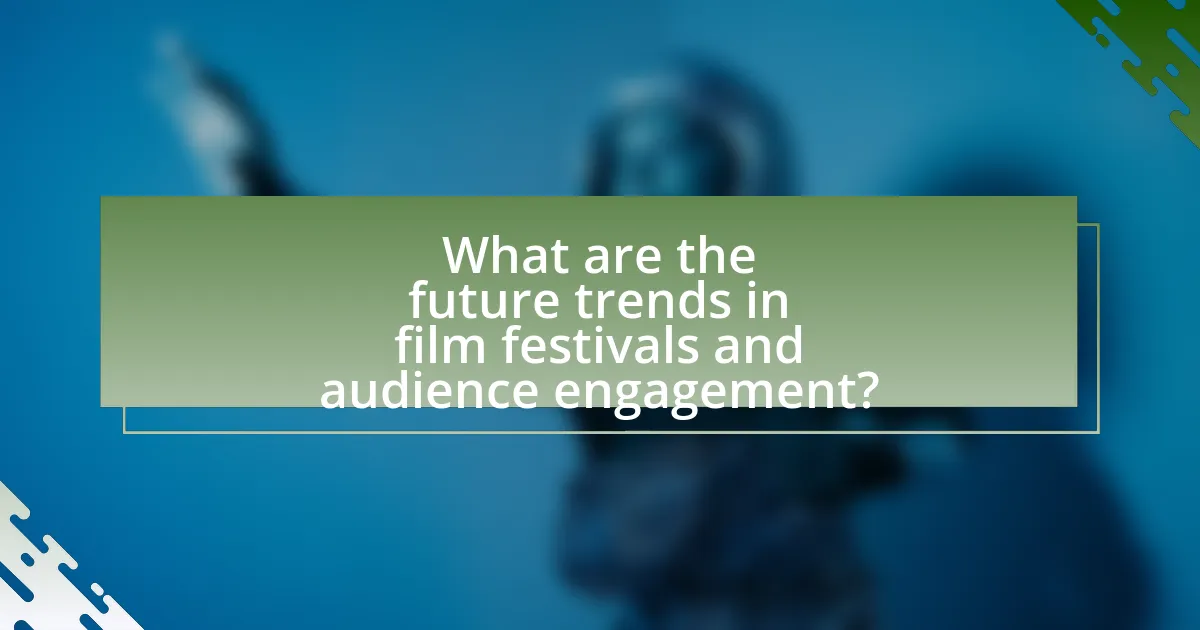
What are the future trends in film festivals and audience engagement?
Future trends in film festivals and audience engagement include increased use of digital platforms, hybrid event formats, and enhanced interactivity. Digital platforms allow festivals to reach global audiences, as seen in the 2021 Sundance Film Festival, which attracted over 100,000 viewers online. Hybrid formats combine in-person screenings with virtual access, catering to diverse audience preferences and expanding reach. Enhanced interactivity, such as live Q&A sessions and audience voting, fosters deeper engagement, exemplified by festivals like Tribeca, which have successfully integrated these elements. These trends reflect a shift towards inclusivity and accessibility in the film festival landscape.
How is technology changing the way audiences experience film festivals?
Technology is transforming audience experiences at film festivals by enabling virtual attendance and enhancing interactivity. With the rise of streaming platforms, festivals like Sundance and Tribeca have incorporated online screenings, allowing global audiences to participate without geographical constraints. This shift has been supported by data indicating that virtual attendance can increase viewership by up to 300%, as reported by the 2021 Sundance Film Festival. Additionally, technology facilitates real-time audience engagement through social media and mobile apps, enabling viewers to interact with filmmakers and other attendees, thereby enriching the overall experience.
What role do virtual and hybrid festivals play in audience reach?
Virtual and hybrid festivals significantly enhance audience reach by removing geographical barriers and increasing accessibility. These formats allow participants from diverse locations to engage with content that they might not have been able to access in traditional, in-person settings. For instance, the 2020 Sundance Film Festival reported a 50% increase in attendance due to its virtual format, attracting over 120,000 viewers compared to 70,000 in previous years. This demonstrates that virtual and hybrid models can effectively broaden the audience base, making festivals more inclusive and diverse.
How can social media influence audience opinions during festivals?
Social media can significantly influence audience opinions during festivals by facilitating real-time engagement and information sharing. Platforms like Twitter and Instagram allow attendees to share their experiences, opinions, and reactions instantly, shaping the perceptions of those who are not present. For instance, a study by the Pew Research Center found that 69% of adults in the U.S. use social media, which amplifies the reach of festival-related content and can sway public opinion based on trending topics and popular posts. Additionally, influencers and celebrities often share their festival experiences, which can create a bandwagon effect, leading to increased interest and altered perceptions among their followers.
What best practices can enhance audience engagement at film festivals?
To enhance audience engagement at film festivals, organizers should implement interactive programming, such as Q&A sessions with filmmakers and panel discussions. These activities encourage direct interaction between the audience and creators, fostering a deeper connection to the films. Research indicates that events featuring filmmaker interactions can increase audience satisfaction and retention rates, as seen in the 2019 Sundance Film Festival, where 70% of attendees reported a more enriching experience due to such engagements. Additionally, utilizing social media platforms for live updates and audience polls during screenings can further enhance participation and excitement, as evidenced by the success of the Toronto International Film Festival’s social media strategy, which significantly boosted audience interaction and feedback.
How can festivals create inclusive environments for diverse audiences?
Festivals can create inclusive environments for diverse audiences by implementing accessible programming, diverse representation, and community engagement initiatives. Accessible programming includes offering materials in multiple languages, providing sign language interpreters, and ensuring physical accessibility at venues. Diverse representation is achieved by featuring films and artists from various cultural backgrounds, which reflects the audience’s diversity and fosters a sense of belonging. Community engagement initiatives, such as workshops and discussions that involve local voices, further enhance inclusivity by allowing audiences to connect with the content on a personal level. Research shows that festivals that prioritize these elements see increased attendance and positive feedback from a wider range of participants, demonstrating the effectiveness of these strategies in fostering inclusivity.
What strategies can filmmakers use to connect with audiences effectively?
Filmmakers can connect with audiences effectively by utilizing relatable storytelling, engaging visuals, and interactive experiences. Relatable storytelling involves crafting narratives that resonate with the audience’s emotions and experiences, which has been shown to enhance viewer engagement and empathy. Engaging visuals, such as high-quality cinematography and innovative editing techniques, capture attention and maintain interest throughout the film. Interactive experiences, such as Q&A sessions or social media engagement during film festivals, foster a sense of community and allow filmmakers to directly address audience feedback, thereby strengthening the connection. Research indicates that films presented at festivals often lead to increased audience discussions and emotional responses, further solidifying the filmmaker’s impact on viewers.
